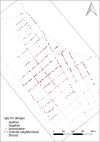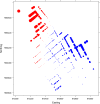Seroprevalence for dengue virus in a hyperendemic area and associated socioeconomic and demographic factors using a cross-sectional design and a geostatistical approach, state of São Paulo, Brazil
- PMID: 31109295
- PMCID: PMC6528304
- DOI: 10.1186/s12879-019-4074-4
Seroprevalence for dengue virus in a hyperendemic area and associated socioeconomic and demographic factors using a cross-sectional design and a geostatistical approach, state of São Paulo, Brazil
Abstract
Background: São José do Rio Preto is one of the cities of the state of São Paulo, Brazil, that is hyperendemic for dengue, with the presence of the four dengue serotypes.
Objectives: to calculate dengue seroprevalence in a neighbourhood of São José do Rio Preto and identify if socioeconomic and demographic covariates are associated with dengue seropositivity.
Methods: A cohort study to evaluate dengue seroprevalence and incidence and associated factors on people aged 10 years or older, was assembled in Vila Toninho neighbourhood, São José do Rio Preto. The participant enrolment occurred from October 2015 to March 2016 (the first wave of the cohort study), when blood samples were collected for serological test (ELISA IgG anti-DENV) and questionnaires were administrated on socio-demographic variables. We evaluated the data collected in this first wave using a cross-sectional design. We considered seropositive the participants that were positive in the serological test (seronegative otherwise). We modelled the seroprevalence with a logistic regression in a geostatistical approach. The Bayesian inference was made using integrated nested Laplace approximations (INLA) coupled with the Stochastic Partial Differential Equation method (SPDE).
Results: We found 986 seropositive individuals for DENV in 1322 individuals surveyed in the study area in the first wave of the cohort study, corresponding to a seroprevalence of 74.6% (95%CI: 72.2-76.9). Between the population that said never had dengue fever, 68.4% (566/828) were dengue seropositive. Older people, non-white and living in a house (instead of in an apartment), were positively associated with dengue seropositivity. We adjusted for the other socioeconomic and demographic covariates, and accounted for residual spatial dependence between observations, which was found to present up to 800 m.
Conclusions: Only one in four people aged 10 years or older did not have contact with any of the serotypes of dengue virus in Vila Toninho neighbourhood in São José do Rio Preto. Age, race and type of house were associated with the occurrence of the disease. The use of INLA in a geostatistical approach in a Bayesian context allowed us to take into account the spatial dependence between the observations and identify the associated covariates to dengue seroprevalence.
Keywords: Brazil; Cross-sectional study; Dengue; Geostatiscal analysis; Seroprevalence.
Conflict of interest statement
The authors declare that they have no competing interests.
Figures




Similar articles
-
Spatial evaluation and modeling of Dengue seroprevalence and vector density in Rio de Janeiro, Brazil.PLoS Negl Trop Dis. 2009 Nov 10;3(11):e545. doi: 10.1371/journal.pntd.0000545. PLoS Negl Trop Dis. 2009. PMID: 19901983 Free PMC article.
-
Assessment of the relationship between entomologic indicators of Aedes aegypti and the epidemic occurrence of dengue virus 3 in a susceptible population, São José do Rio Preto, São Paulo, Brazil.Acta Trop. 2015 Feb;142:167-77. doi: 10.1016/j.actatropica.2014.11.017. Epub 2014 Dec 4. Acta Trop. 2015. PMID: 25484110
-
Dengue RNA detection and seroprevalence in blood donors during an outbreak in the São Paulo State, Brazil, 2016.J Med Virol. 2021 Jun;93(6):3344-3349. doi: 10.1002/jmv.26619. Epub 2020 Oct 30. J Med Virol. 2021. PMID: 33090520
-
Seroprevalence and risk factors for dengue infection in socio-economically distinct areas of Recife, Brazil.Acta Trop. 2010 Mar;113(3):234-40. doi: 10.1016/j.actatropica.2009.10.021. Epub 2009 Nov 6. Acta Trop. 2010. PMID: 19896921 Free PMC article.
-
Origin, tempo, and mode of the spread of DENV-4 Genotype IIB across the state of São Paulo, Brazil during the 2012-2013 outbreak.Mem Inst Oswaldo Cruz. 2019 Jan 7;114:e180251. doi: 10.1590/0074-02760180251. Mem Inst Oswaldo Cruz. 2019. PMID: 30624458 Free PMC article. Review.
Cited by
-
Socioeconomic risk markers of arthropod-borne virus (arbovirus) infections: a systematic literature review and meta-analysis.BMJ Glob Health. 2022 Apr;7(4):e007735. doi: 10.1136/bmjgh-2021-007735. BMJ Glob Health. 2022. PMID: 35428678 Free PMC article.
-
Potential risk sites and their relationship with dengue cases, Campinas municipality, Southeast Brazil.PLoS Negl Trop Dis. 2023 Apr 27;17(4):e0011237. doi: 10.1371/journal.pntd.0011237. eCollection 2023 Apr. PLoS Negl Trop Dis. 2023. PMID: 37104540 Free PMC article.
-
Cryptic circulation of chikungunya virus in São Jose do Rio Preto, Brazil, 2015-2019.PLoS Negl Trop Dis. 2024 Mar 14;18(3):e0012013. doi: 10.1371/journal.pntd.0012013. eCollection 2024 Mar. PLoS Negl Trop Dis. 2024. PMID: 38484018 Free PMC article.
-
Influence of previous Zika virus infection on acute dengue episode.PLoS Negl Trop Dis. 2023 Nov 9;17(11):e0011710. doi: 10.1371/journal.pntd.0011710. eCollection 2023 Nov. PLoS Negl Trop Dis. 2023. PMID: 37943879 Free PMC article.
-
Cardiac Biomarkers in a Brazilian Indigenous Population Exposed to Arboviruses: A Cross-Sectional Study.Viruses. 2024 Dec 10;16(12):1902. doi: 10.3390/v16121902. Viruses. 2024. PMID: 39772209 Free PMC article.
References
-
- Vos T, Allen C, Arora M, Barber RM, Bhutta ZA, Brown A, et al. Global, regional, and national incidence, prevalence, and years lived with disability for 310 diseases and injuries, 1990–2015: a systematic analysis for the global burden of disease study 2015. Lancet. 2016;388:1545–1602. doi: 10.1016/S0140-6736(16)31678-6.. - DOI - PMC - PubMed

